
At Aerofarms, stacks of LED strip lights tower overhead, flooding every last inch of my view of the industrial warehouse in a fluorescent white. As I make my way through the seemingly never-ending space, a pink neon glow greets me at the back wall. "We're playing around with different light spectrums here—the plants love it," says Alina, my tour guide for the day. I'm not immersed in some science laboratory, light showroom, or IKEA warehouse. I'm standing smack-dab in the middle of one of the highest yielding farms in the New York metro area.
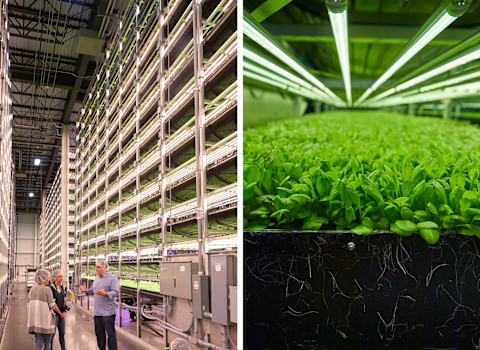
The high-tech brainchild of a conservation expert and a Cornell professor with a knack for artificial intelligence, Aerofarms seeks to add more science and control to the farming industry in order to increase yield. Its global headquarters, spanning 70,000 square feet of an abandoned steel mill in Newark, New Jersey, is the largest indoor vertical farm in the world based on growing capacity. Aerofarms' third and largest farm in the city houses 30 crop harvests a year, compared to the two to three typical of your standard farm, all the while using 50 percent less fertilizer and 95 percent less water.
"The point is to get people excited about greens and different ways of farming that are better for us and the planet," Aerofarms' co-founder Marc Oshima tells me on my tour. "In terms of driving innovation in agriculture, you need success stories to share with people."

A complex system of wires, cloth, and patented lighting technology are behind the farm's high yield and low environmental footprint. Aerofarms is an aeroponic operation, meaning it replaces soil with a nutrient-packed mist. Seeds are placed atop a reusable cloth made from recycled bottles, fed using a complex watering system that delivers nutrients tailored specifically to them, and grown under LED lights that simulate the sun. But here's the kicker: Aerofarms seeks to improve the natural rhythms of the Earth, not mimic them. Plants are grown year-round in a temperature-controlled environment, and the light and nutrient levels shift in order to best suit the plants. Sometimes the humidity and temperature stay consistent for weeks. Sometimes the "sun" never sets on the farm.
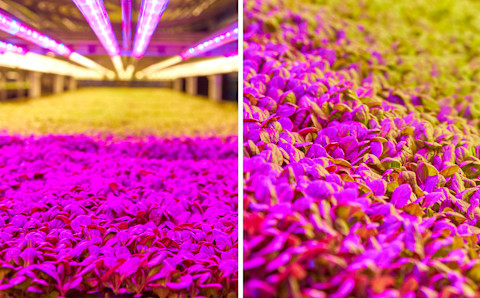
This science-driven growing method comes with its share of sustainable benefits. No soil means no pests and therefore no pesticides. Stacking means less land use. The farm collects and reuses water in a closed-loop nutrient reservoir, and alternative energy fuels the whole operation.
A hungry market.
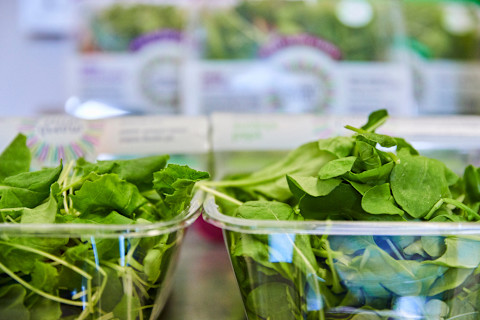
If you're imagining the resulting produce as some sort of dystopian, too-green-to-be-true science experiment, think again. A post-tour taste test yielded crisp, floral watercress, peppery arugula, and kale that was shockingly easy to digest. I tried six varieties of lettuce, and I honestly never knew greens could taste so vibrantly different.
Though Aerofarms is constantly testing new plants to add to the lineup, right now it only mass-produces leafy greens that are short enough for plenty of stacking. After a growing period that lasts around 12 days, these greens are packaged on-site and shipped to grocery stores and restaurants within 24 hours under the "Dream Greens" label. This ultra-fresh, local produce has garnered quite a reputation among area chefs, and restaurant partners in NYC are lining up to stock the delicious greens.

Sixty percent of the world's population will likely live in cities by the year 2030, so models like Aerofarms that grow food for urbanites using less land and less transportation are only going to become more important.
Aerofarms' headquarters is still in development, and once complete it will send out 1.5 to 2 million tons of produce a year. That may sound like a lot, but when you consider how massive the food industry is, it's really just a drop in the ocean. When I asked Alina Zolotareva, the farm's marketing manager, if she sees this system becoming the future of farming, she said, "Vertical farming won’t ever replace traditional agriculture, but it can make a really big dent."

That's an important distinction. In order to feed the cities of the future in a sustainable way, we also need to keep some element of traditional farming intact. Namely, its reverence for nature.
That's where urban farms like Swale and Gotham Greens come in.
The natural solution.
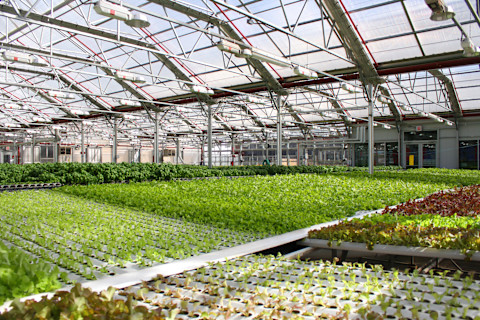
Gotham Greens, a produce company with four rooftop greenhouse locations across New York and Chicago, is another incredibly sustainable operation that forgoes soil in favor of water infused with nutrients. However, its farms still rely on the sun's natural rhythms to grow crops, and they more closely resemble traditional farmland—albeit farmland perched on urban roofs.
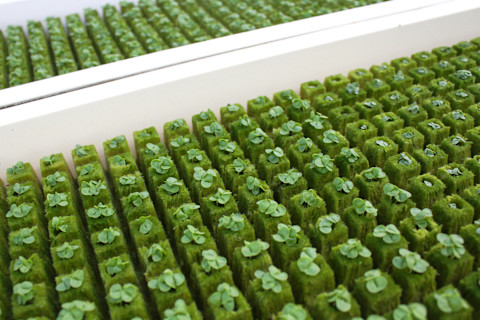
Its Brooklyn location, which sits atop the local Whole Foods, feels ingrained in the local community. Shoppers can peek into its windows to see where the lettuce they picked up downstairs came from, and local schools and organizations are welcome to pick up some seedlings for their own growing projects. A quick Instagram search of #gothamgrows delivers snapshots of people of all ages and backgrounds coming together to press pause on the chaos of city life and get their hands dirty.
My time aboard Swale—yes, it's a farm on a boat—had a similarly communal, collaborative feel. Artist Mary Mattingly started the project as a way to bypass rules against growing on public land in New York by starting a farm on the water. The resulting "floating food forests" welcomes passers-by to pick produce to the motion of the tide. Yes, it's limited to the square footage of a barge so it won't have everything that a grocery store does, and yes, your time aboard may make you a little boat sick, but Swale reminds you that nature's glory lies in its imperfection.
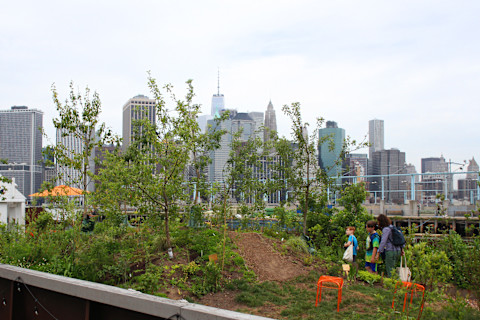
"The future of food should go hand in hand with heritage and history," Lindsey Grothkopp, who handles communications for the boat, told me. "It's exciting for kids to see and touch the food. When you plant in this context, you see the whole system."
It's in combining this natural beauty with engineered efficiency that we'll be able to craft a food system that withstands the test of time.
Hungry for more food innovation? Check out these urban farms across the country and meet the family growing 6,000 pounds of food in their LA backyard.
